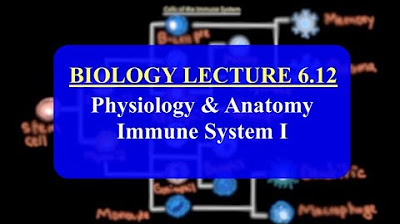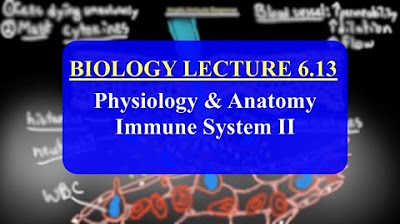11-3 Phagocytes: Neutrophils & Macrophages (Cambridge AS A Level Biology, 9700)
Summary
TLDRThis video explains the role of phagocytes in the immune system, focusing on neutrophils and macrophages. Phagocytes are white blood cells that protect the body by engulfing and digesting pathogens through phagocytosis. The transcript covers how these cells are formed in the bone marrow and how they function to clear infections. Neutrophils are short-lived and do not present antigens, while macrophages live longer and play a key role in antigen presentation, activating other immune cells. The video also highlights the formation of these cells from blood stem cells and their shared and unique characteristics in immune defense.
Takeaways
- 😀 White blood cells (leukocytes) are divided into two main categories: external and internal defense systems.
- 😀 The immune system's internal defense includes white blood cells, also known as leucocytes or leukocytes.
- 😀 Phagocytes, which include neutrophils and macrophages, are key types of white blood cells responsible for engulfing pathogens.
- 😀 Phagocytes can be compared to the Pac-Man character because they engulf or 'eat' pathogens in a process known as phagocytosis.
- 😀 Phagocytes are formed in the bone marrow from blood stem cells, which divide to produce neutrophils and monocytes.
- 😀 Neutrophils generally remain in the blood, while monocytes can leave the blood and become macrophages in tissues.
- 😀 Neutrophils and macrophages both carry out phagocytosis, where they engulf pathogens and digest them using enzymes in lysosomes.
- 😀 Lysosomes, which contain digestive enzymes, are crucial for breaking down pathogens engulfed by phagocytes.
- 😀 Neutrophils have a short lifespan and die after engulfing a few pathogens, while macrophages are longer-lasting and can continue to fight pathogens for a longer period.
- 😀 Macrophages can present antigens (foreign proteins) on their cell surface, a process called antigen presentation, which is important for activating other immune cells, like helper T lymphocytes.
Q & A
What are white blood cells, and what role do they play in the immune system?
-White blood cells, also known as leukocytes or leucocytes, are crucial components of the immune system. They help protect the body from infections by detecting and attacking pathogens like bacteria, viruses, and other harmful microorganisms.
What is the main focus of the video regarding white blood cells?
-The video focuses on **phagocytes**, a type of white blood cell responsible for engulfing and digesting pathogens. Specifically, it discusses two types of phagocytes: neutrophils and macrophages.
How are phagocytes formed in the body?
-Phagocytes are formed in the bone marrow from blood stem cells. These stem cells differentiate into different types of blood cells, including neutrophils and monocytes. Monocytes then leave the blood and develop into macrophages in tissues.
What is phagocytosis, and how does it work?
-Phagocytosis is a process in which a phagocyte engulfs and digests pathogens. The phagocyte detects the pathogen, engulfs it by folding its membrane around it, and forms a vesicle. Then, lysosomal enzymes break down the pathogen inside the phagocyte.
What are the key similarities between neutrophils and macrophages?
-Both neutrophils and macrophages perform phagocytosis, engulfing and digesting pathogens to protect the body. They both also contain lysosomes filled with digestive enzymes to break down pathogens.
What are the differences between neutrophils and macrophages?
-The main differences are that neutrophils are short-lived, dying after consuming a few pathogens, while macrophages are longer-lived and can continue to consume pathogens for a longer period. Additionally, macrophages engage in antigen presentation, which neutrophils do not.
Why do neutrophils have a short lifespan compared to macrophages?
-Neutrophils are short-lived because they are designed to respond quickly to infection, consuming pathogens until they die. In contrast, macrophages can produce more energy (ATP) and have more lysosomes, enabling them to survive longer and continue fighting infections.
What is antigen presentation, and why is it important?
-Antigen presentation is a process where macrophages display fragments of pathogens (antigens) on their surface after digesting them. This is important because it helps activate T lymphocytes, which are essential for initiating the adaptive immune response.
What role do antigens play in the immune system?
-Antigens are foreign proteins, glycoproteins, or glycolipids found on pathogens. They are recognized by the immune system as markers of infection, triggering immune responses such as phagocytosis and the activation of T cells.
Why do macrophages perform antigen presentation but neutrophils do not?
-Macrophages perform antigen presentation to help activate helper T lymphocytes, which play a key role in the adaptive immune response. Neutrophils, on the other hand, are primarily focused on the immediate destruction of pathogens and do not carry out antigen presentation.
Outlines

This section is available to paid users only. Please upgrade to access this part.
Upgrade NowMindmap

This section is available to paid users only. Please upgrade to access this part.
Upgrade NowKeywords

This section is available to paid users only. Please upgrade to access this part.
Upgrade NowHighlights

This section is available to paid users only. Please upgrade to access this part.
Upgrade NowTranscripts

This section is available to paid users only. Please upgrade to access this part.
Upgrade NowBrowse More Related Video

sistem pertahanan tubuh non spesifik internal - imun lapisan ke 2 bab sistem imun kelas 11 biologi

IMAT Biology Lesson 6.12 | Anatomy and Physiology | Immune System Part I

B Komponen Sistem Pertahanan Tubuh

Respon imun bawaan: Proses Inflamasi

IMAT Biology Lesson 6.13 | Anatomy and Physiology | Immune System Part II

biologi bab sistem imun - Reaksi inflamasi sistem pertahanan tubuh. kelas 11 semester 2
5.0 / 5 (0 votes)